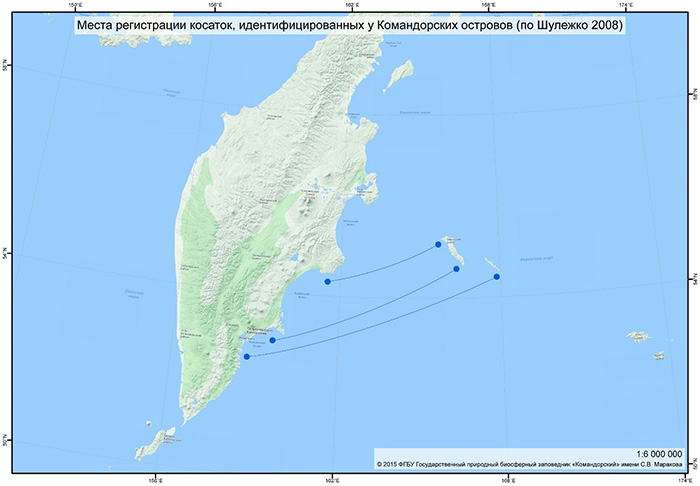The Killer Whale Orcinus orca Linnaeus, 1758
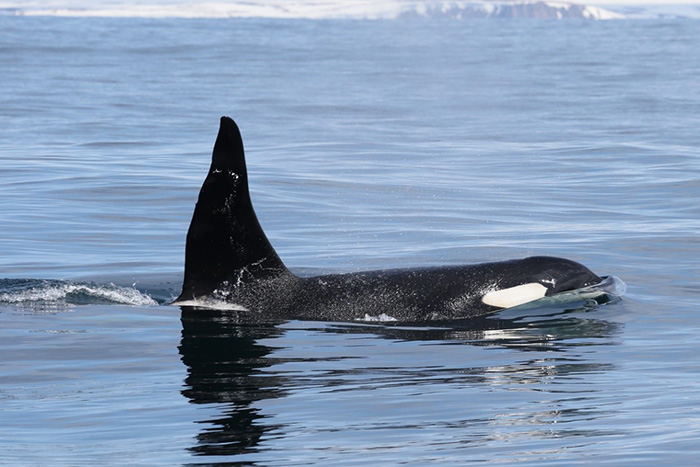
Adult male killer whale. Photograph by Eugene Mamaev
The body length of adult males is from 5.5 to 10 m (killer whales feeding on marine mammals are smaller than fish-eating ones). Females are much smaller. The weight is up to 11 tons (7.5 tons average). Newborns can be up to 2.4 m long and weigh up to 180 kg.
Killer whales can be seen in almost all seas and oceans. This is one of the most widespread species of mammals on the planet.
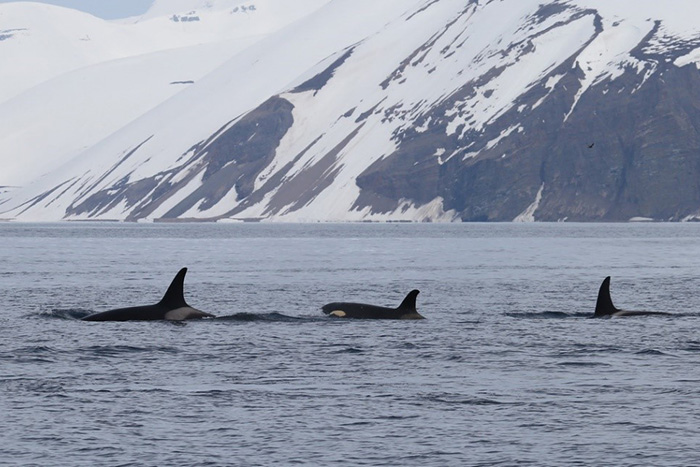
In early spring the number of killer whales off the coast of the Commander Islands increases. Photograph by Eugene Mamaev
Killer whales are a very heterogeneous and are, probably, a group of close species which differ in their genetic, morphological, ecological and behavioral structure. In the near future, apparently, the species will be divided into several species and/or subspecies. It is therefore not surprising that the ration of killer whales is very diverse and includes cephalopods, fish, seabirds, marine mammals. While some killer whales feed almost exclusively on fish (they are called fish-eating), others feed only on marine mammals (they are called mammal-eating).
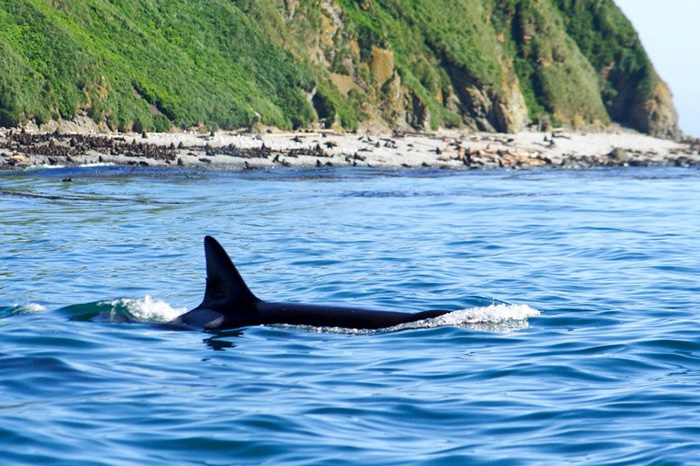
Mammal-eating orcas come close to the rookeries of marine mammals to hunt for the northern fur seal. Photograph by Alexey Chetvergov
Orcas can dive for 4 to 15 minutes. The maximum swimming speed is up to 55 km/h.
In the time of whaling the killer whale was not the main goal and it was killed in relatively small quantities.
Killer whales live in families consisting of several generations, including descendants of the older female. The family has got relatives at the level of an uncle and an aunt, a sister and a brother, a mother and a daughter/son, a grandmother. But in families of killer whales there are no spouses, fathers and grandfathers. For breeding different families meet each other to meet a short-term partner, then everyone reunites with their family. Females give birth with their families. After the birth, and perhaps even in the mother’s womb, newborns are taught the vocal repertoire of their group, which is individual, with the help of which the group can distinguish its members from others. Thanks to this specific dialect individual group members do not get lost at meeting places of several groups, and the whole group preserves its integrity. New families are occasionally formed when one of the females together with a part of individuals of its group separates from it. These groups kindred in the recent past preserve a similar set of sounds and acquire some new sounds; scientists unite close groups in tribes, tribes in clans and so on. Thus, the social organization of orcas is extremely complex and dynamic.
Apart from the segregation of killer whales by vocal dialects, orcas are also divided into ecological types by feeding behavior. So, killer whales which feed only on fish never (hundreds of thousands of years already) come into contact with orcas hunting marine mammals. These types of orcas behave independently as completely different species.

Groups of fish-eating killer whales are numerous. Photograph by Eugene Mamaev
The total number of killer whales is very approximate and estimated at 50000 individuals, or even more.
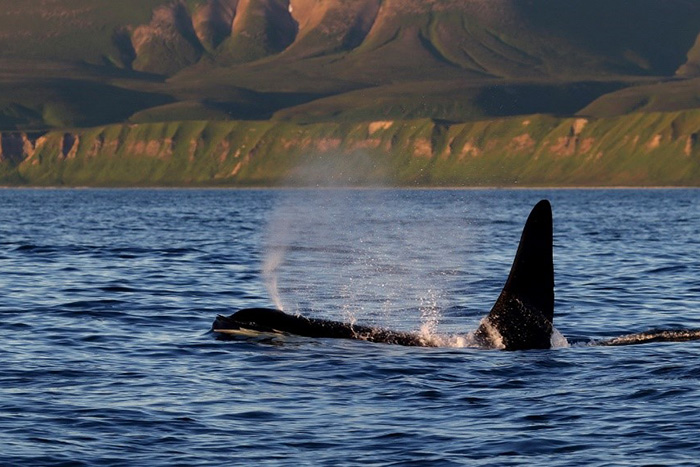
In summer killer whales are rather typical of the coasts of the Commander Islands. Photograph by Eugene Mamaev
The first reference to the killer whale as a species of fauna in the waters of the Commander Islands dates from the end of the 19th century in Leonhard Stejneger’s work.
The killer whale is a typical and numerous species of Cetacean in the waters of the islands. Mammal eating orcas as well as fish-eating orcas live here. They can be seen here throughout the year, but in the summer months their number increases a lot.
Off the islands fish-eating killer whales stay together in family groups of 7 to 20 animals, and up to 50 animals can be seen in places which are more beneficial for feeding. Even clusters of up to 200 animals have been observed. Fish-eating killer whales can be seen almost at any point in the waters of the islands, but they are more likely to be met along the west coast of Bering Island and the southern extremity of Medny Island.
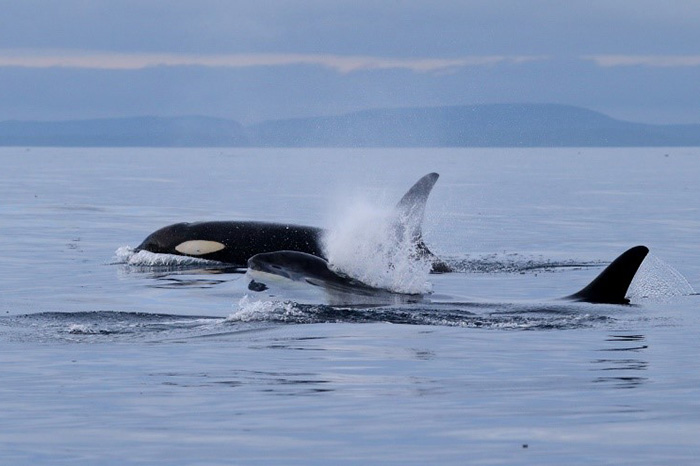
Fish-eating killer whales are often found in open waters, their usual route goes along the shelf edge near the west coast of Bering Island. Photograph by Eugene Mamaev
Mammal-eating orcas are also common here. Their groups consist of 2 to 7 or a little more individuals. The core of a group can consist of the same members for years; sometimes there are newcomers. Off the southeastern rookery on Medny Island one of the groups of mammal-eating killer whales has been observed at least since 2003. In the waters of the Commander Islands cases of killer whales’ attacks have been registered on northern fur seal, the harbor seal, the sea otter, Dall's porpoise and the fin whale. Killer whales’ hunting northern fur seals are observed in all four breeding rookeries of northern fur seals on the Commander Islands.
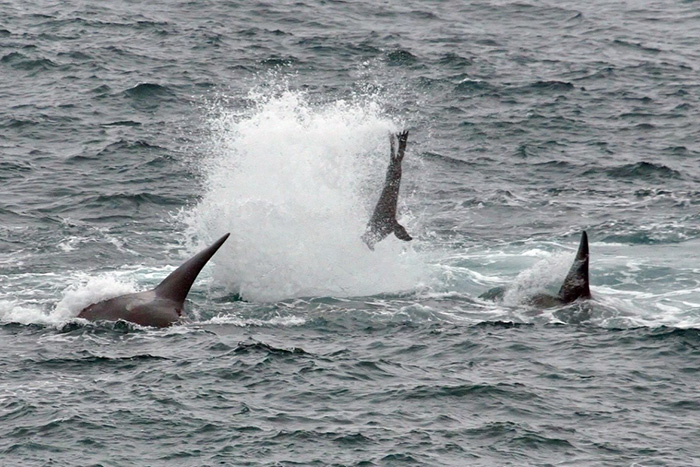
The northern fur seal is the principal food source of mammal-eating killer whales off the Commander Islands. Photograph by Eugene Mamaev
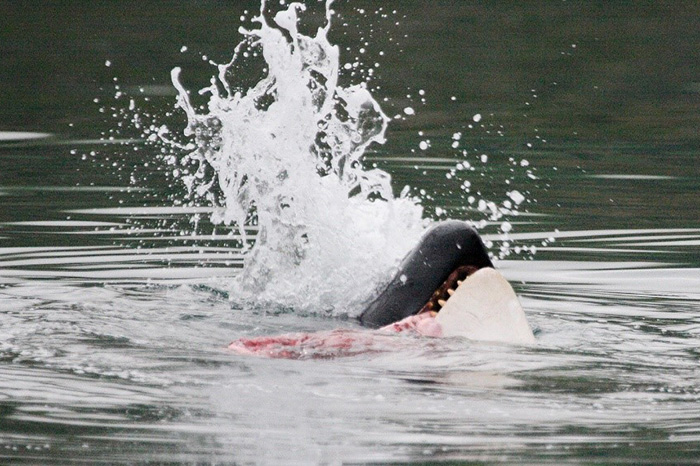
After a successful hunt orcas immediately eat the prey. Photograph by Alexey Chetvergov
Due to research it is established that the waters of the Commander Islands are a transit area and animals registered near the island can be found off the coast of Kamchatka. So, killer whales which were registered near the Commander Islands were observed off the eastern coast of Kamchatka at a distance of 500 to 1097 km. It is unknown where fish-eating killer whales spend their winter months. Mammal-eating killer whales spend winter and spring, apparently, in the warm tropical waters, in places of wintering of northern fur seal, as indicated by the marks on their skin from the bites of tropical sharks.
Places of registration of killer whales, identified on the Commander Islands (according to Shuleshko 2008)
In 30-50s of the last century a question regarding shooting killer whales on the Commander Islands was raised, as they did fur seal keeping industry a lot of harm.
The exact number of fish-eating killer whales in the waters of the Commander Islands is unknown, but apparently, during a year several hundreds of these animals go through these waters. Several groups of mammal-eating killer whales are registered at the rookeries of northern fur seals every year.









